 We all know how important fruits and vegetables are to a healthy diet. Federal guidelines recommend that adults get at least 2 to 3 cups of vegetables per day but just 1 in 10 adults actually meets these recommendations, according to the Center for Disease Control. October is National Vegetarian Awareness Month and the perfect time to explore ways of incorporating more vegetables into your diet and to seek out tasty vegetarian recipes. The North American Vegetarian Society promotes vegetarianism because they believe that a “vegetarian diet has proven health benefits, saves animals’ lives and helps to preserve the Earth.” To learn more about vegetarianism, check out one of the books from the WU Reads Reading Guide.
We all know how important fruits and vegetables are to a healthy diet. Federal guidelines recommend that adults get at least 2 to 3 cups of vegetables per day but just 1 in 10 adults actually meets these recommendations, according to the Center for Disease Control. October is National Vegetarian Awareness Month and the perfect time to explore ways of incorporating more vegetables into your diet and to seek out tasty vegetarian recipes. The North American Vegetarian Society promotes vegetarianism because they believe that a “vegetarian diet has proven health benefits, saves animals’ lives and helps to preserve the Earth.” To learn more about vegetarianism, check out one of the books from the WU Reads Reading Guide.
Library News
Play On…
 In 1994, President Bill Clinton signed Proclamation 6716 designating September to be Classical Music Month. The proclamation aptly declares that “classical music speaks both to the mind and to the heart, giving us something to think about as well as to experience.” When we consider the many talented composers, conductors, and musicians who have created and shared classical music with us through the ages, it seems appropriate that we take time to honor them one and all for their wonderful artistry. So tune in to your classical music radio station, attend a local symphony concert, or checkout one of the books from the WU Reads Reading Guide and join us in celebrating this special month!
In 1994, President Bill Clinton signed Proclamation 6716 designating September to be Classical Music Month. The proclamation aptly declares that “classical music speaks both to the mind and to the heart, giving us something to think about as well as to experience.” When we consider the many talented composers, conductors, and musicians who have created and shared classical music with us through the ages, it seems appropriate that we take time to honor them one and all for their wonderful artistry. So tune in to your classical music radio station, attend a local symphony concert, or checkout one of the books from the WU Reads Reading Guide and join us in celebrating this special month!
“Music was my refuge. I could crawl into the space between the notes and curl my back to loneliness.”–Maya Angelou
Food, Glorious Food
 There is a month for every occasion and July is no exception. Join us as we celebrate National Culinary Arts Month! This month recognizes the cooks, chefs, bakers, and food lovers who bring joy to our plates every day. Food is a significant part of every culture; it connects, sustains, delights, and inspires us. Many of us have favorite recipes from a cherished friend or family member no longer on this earth and every time we prepare that dish or bake those cookies, we are immediately swept up in treasured memories of that important loved one. National Culinary Arts Month is all about taking the time to think about the foods we put on our tables, considering the recipes that have been passed down through the generations, and celebrating the skill, dedication, and artistry required to be a great cook or chef. Be sure and check out the WU Reads Reading Guide for an interesting selection of cooking-related books for your reading pleasure!
There is a month for every occasion and July is no exception. Join us as we celebrate National Culinary Arts Month! This month recognizes the cooks, chefs, bakers, and food lovers who bring joy to our plates every day. Food is a significant part of every culture; it connects, sustains, delights, and inspires us. Many of us have favorite recipes from a cherished friend or family member no longer on this earth and every time we prepare that dish or bake those cookies, we are immediately swept up in treasured memories of that important loved one. National Culinary Arts Month is all about taking the time to think about the foods we put on our tables, considering the recipes that have been passed down through the generations, and celebrating the skill, dedication, and artistry required to be a great cook or chef. Be sure and check out the WU Reads Reading Guide for an interesting selection of cooking-related books for your reading pleasure!
Ode to the Ocean
 Did you know that over 70% of the Earth’s surface is covered by ocean waters? And over half of the world’s population is estimated to live near coastal areas. Ties between humans and the global ocean are numerous and vast; they include economic, environmental, health, and spiritual links, just to name a few. The ocean is teeming with life and filled with extraordinary and mysterious creatures of all sorts that have fascinated humankind forever. It has been an inspiration to early explorers, scientists, artists, musicians, authors, and more for centuries. The ocean provokes an emotional response from most of us; the sight of the ocean stretching unendingly before us as we stand upon the shore boggles the mind, the feel of the waves on our bare feet tickles and delights us, and the sound of the ocean both comforts and energizes us. In celebration of the magic of the ocean, June has been proclaimed “National Ocean Month.” You can learn all about the ocean from the National Oceanic and Atmospheric Administration, including information about estuaries, marine sanctuaries, coral reefs, and much more. And don’t forget to check out the assortment of ocean-related books listed on our WU Reads Reading Guide!
Did you know that over 70% of the Earth’s surface is covered by ocean waters? And over half of the world’s population is estimated to live near coastal areas. Ties between humans and the global ocean are numerous and vast; they include economic, environmental, health, and spiritual links, just to name a few. The ocean is teeming with life and filled with extraordinary and mysterious creatures of all sorts that have fascinated humankind forever. It has been an inspiration to early explorers, scientists, artists, musicians, authors, and more for centuries. The ocean provokes an emotional response from most of us; the sight of the ocean stretching unendingly before us as we stand upon the shore boggles the mind, the feel of the waves on our bare feet tickles and delights us, and the sound of the ocean both comforts and energizes us. In celebration of the magic of the ocean, June has been proclaimed “National Ocean Month.” You can learn all about the ocean from the National Oceanic and Atmospheric Administration, including information about estuaries, marine sanctuaries, coral reefs, and much more. And don’t forget to check out the assortment of ocean-related books listed on our WU Reads Reading Guide!
Celebrating Short Stories

Image by: https://dorothyjoseph.com
How many of us remember our discomfort and increasing anxiety when reading Edgar Allan Poe’s story “The Tell Tale Heart” or “The Lottery” by Shirley Jackson? What about those monkeys in “Interpreter of Maladies” by Jhumpa Lahiri? Short stories have the power to thrill, horrify, tantalize, and enchant us. They show us beauty, make us examine uncomfortable subjects, and stick with us long after the last word of the story has been read.
Encouraged by the success of April’s National Poetry Month, May has been declared International Short Story Month. Everyone is encouraged to read and share short stories throughout the month. You can even participate in the “A Story a Day” challenge in which writers write and finish a short story every day in May.
Join us in celebrating Short Story Month by reading a short story today! Looking for short story suggestions? Check out the books listed on our WU Reads Reading Guide.
National Poetry Month
 The Academy of American Poets founded National Poetry Month in April 1996 to celebrate “poetry’s vital place in our culture.” One of the primary goals of the month is to “highlight the extraordinary legacy and ongoing achievement of American poets.” Over the years, Poetry Month has become a huge literary observance with readers, students, teachers, librarians, booksellers, publishers, and poets from around the world participating in this month-long celebration in a whole host of different ways. Many special events and readings are scheduled to occur during April in honor of poetry. Over 100,000 National Poetry Month posters are distributed to schools, libraries, and bookstores each year. On April 18, poetry lovers are encouraged to participate in “Poem in Your Pocket Day.” On this day, select a poem, carry it with you, and share it with others wherever you go!
The Academy of American Poets founded National Poetry Month in April 1996 to celebrate “poetry’s vital place in our culture.” One of the primary goals of the month is to “highlight the extraordinary legacy and ongoing achievement of American poets.” Over the years, Poetry Month has become a huge literary observance with readers, students, teachers, librarians, booksellers, publishers, and poets from around the world participating in this month-long celebration in a whole host of different ways. Many special events and readings are scheduled to occur during April in honor of poetry. Over 100,000 National Poetry Month posters are distributed to schools, libraries, and bookstores each year. On April 18, poetry lovers are encouraged to participate in “Poem in Your Pocket Day.” On this day, select a poem, carry it with you, and share it with others wherever you go!
To find out more about National Poetry Month, check out poets.org. And go to the WU Reads Reading Guide for an interesting selection of recent books of poetry available in our collection.
Salute to Social Workers
 Every day across the United States, hundreds of thousands of social workers work to support, protect and empower millions of people as they struggle to deal with and solve problems in their day-to-day lives. According to the Occupational Outlook Handbook, the job outlook for social workers is growing rapidly and “is projected to grow 16% from 2016-2026, which is much faster than the average for all occupations.” Sadly, the important work of social workers is often underappreciated and frequently underpaid. The month of March has been set aside to pay tribute to all the dedicated social workers out there and to acknowledge their important contributions to society. “Elevate” is the theme for this year’s National Social Work Month and this theme was chosen in an effort to call attention to social workers endeavors to elevate people and also to point out the need to elevate the pay of social workers. To find out more about the social work profession, check out the National Association of Social Workers website. And go to the WU Reads Reading Guide for some interesting books on social work and social service.
Every day across the United States, hundreds of thousands of social workers work to support, protect and empower millions of people as they struggle to deal with and solve problems in their day-to-day lives. According to the Occupational Outlook Handbook, the job outlook for social workers is growing rapidly and “is projected to grow 16% from 2016-2026, which is much faster than the average for all occupations.” Sadly, the important work of social workers is often underappreciated and frequently underpaid. The month of March has been set aside to pay tribute to all the dedicated social workers out there and to acknowledge their important contributions to society. “Elevate” is the theme for this year’s National Social Work Month and this theme was chosen in an effort to call attention to social workers endeavors to elevate people and also to point out the need to elevate the pay of social workers. To find out more about the social work profession, check out the National Association of Social Workers website. And go to the WU Reads Reading Guide for some interesting books on social work and social service.
Oregon: The Early Years
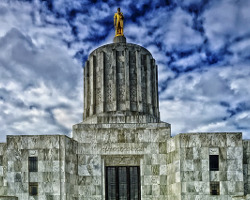 One hundred and sixty years ago, on February 14, 1859, Oregon was officially admitted to the union as the 33rd state. In the grand scheme of things, that really isn’t that long ago but the years leading up to and shortly after becoming a state are jammed pack with interesting stories. Long before traders, explorers and pioneers began showing up in the state, many indigenous tribes called this area home. The history of Oregon and the stories of the Native Americans and the settlers who ventured here along the Oregon Trail make fascinating topics for exploration. In tribute to Oregon’s statehood, it seems appropriate for us to learn more about the native peoples of this land and the early Westerners that settled the Oregon Territory and eventually created this state. To start you out on this exploration, check out the WU Reads Reading Guide for some interesting books on early Oregon history.
One hundred and sixty years ago, on February 14, 1859, Oregon was officially admitted to the union as the 33rd state. In the grand scheme of things, that really isn’t that long ago but the years leading up to and shortly after becoming a state are jammed pack with interesting stories. Long before traders, explorers and pioneers began showing up in the state, many indigenous tribes called this area home. The history of Oregon and the stories of the Native Americans and the settlers who ventured here along the Oregon Trail make fascinating topics for exploration. In tribute to Oregon’s statehood, it seems appropriate for us to learn more about the native peoples of this land and the early Westerners that settled the Oregon Territory and eventually created this state. To start you out on this exploration, check out the WU Reads Reading Guide for some interesting books on early Oregon history.
Wonderful World of Winter
 Winter is coming and we’re not talking about The Game of Thrones. No, we’re talking about the time of year when the days are shorter, the nights are longer, and the weather is cooler. In Salem, it’s a time of blustery days, soaking rains, and perhaps even the occasional snow storm. This time of year can be a wonderful time to head for the coast to watch wild waves while avoiding the summer crowds. If you don’t mind the rain, hikes at Silver Creek Falls can be rewarding–the falls are impressive with all the rain and the crowds are greatly diminished. Or head to the mountain for snow fun of all kinds. It is also prime time for wearing cozy sweaters, sitting by the fire, drinking cocoa, and–you guessed it–reading a good book! If you need some good winter-themed reading material, check out our WU Reads Reading Guide.
Winter is coming and we’re not talking about The Game of Thrones. No, we’re talking about the time of year when the days are shorter, the nights are longer, and the weather is cooler. In Salem, it’s a time of blustery days, soaking rains, and perhaps even the occasional snow storm. This time of year can be a wonderful time to head for the coast to watch wild waves while avoiding the summer crowds. If you don’t mind the rain, hikes at Silver Creek Falls can be rewarding–the falls are impressive with all the rain and the crowds are greatly diminished. Or head to the mountain for snow fun of all kinds. It is also prime time for wearing cozy sweaters, sitting by the fire, drinking cocoa, and–you guessed it–reading a good book! If you need some good winter-themed reading material, check out our WU Reads Reading Guide.
WU Libraries: Past, Present, and Future
By Joni Roberts
Most of us know that Willamette University has been in existence for over 175 illustrious years but it is not exactly clear when a library officially appeared on the scene. The student newspaper, The Willamette Collegian, which began publication in 1875, first mentions the library in 1876. This article describes how the library was located on the first floor of Waller Hall along with the chapel and the “ladies’ and gentlemens’ reception rooms.” Mention of the library in the early years of the Collegian often consists of imploring students, faculty and friends of Willamette to donate much needed books to the library.

Library reading room in Waller Hall, early 1920s
Dr. Robert Gatke (d. 1968), Willamette historian and professor, mentions the library a few times in his book Chronicles of Willamette. His description of the library around 1915 is far from flattering: “The library was the pathetic victim of malnutrition. With no regular appropriation made for the purchase of books, it depended upon gifts, receiving mostly old books of no value for reference use and not placing within reach of the students the new thought stimulating books as they came from the presses.”
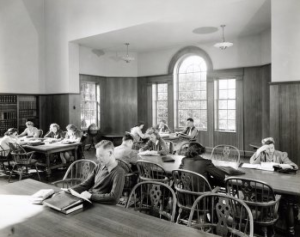
Library reading room in 1948 in what is now Smullin Hall
Describing the library in the early 1930’s, Gatke writes “…library housing was inadequate and the weight of the books on the second floor of Waller had become so great that it constituted a serious danger to safety.” The construction of a new library building was approved in 1937 and the building was dedicated in May of 1938. At the time of the dedication, the building housed no books but on May 20th, classes were cancelled and students and faculty carried the books from Waller to the new building, the current day Smullin Hall.
An addition was added to the building in 1965-66 but before too long, it was determined that the library was no longer adequate and that renovation was not a viable solution. A building program statement issued by then University Librarian Patricia Stockton in 1980 describes poor lighting, ventilation, heating and a lack of a classroom for instruction sessions. The report states: “The Library is not inviting to the user. Most seating is at long study tables in the two main reading areas. The remainder is in individual study carrels on bare cement floors under buzzing lights. The bookstacks themselves are too crowded, too narrow, and their color is a bilious green.”
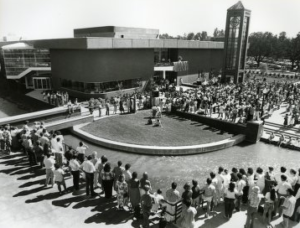
Mark O. Hatfield Library dedication, 1986
Happily, approval of a new library building was granted and the present-day library opened in 1986. Students and faculty once again helped move materials from the old building to the new. The Mark O. Hatfield Library, a tribute to one of Willamette’s most distinguished graduates, was considered state of the art at the time of its dedication. Overlooking the Mill Race and adjacent to Jackson Plaza, today’s library is centrally located in the heart of the campus. The library is a vital public space and includes many attractive areas suitable for study and reflection.
The library building is now over 30 years old and while minor renovations have occurred over the years, the library is due for a more substantial remodel. The library staff has many ideas for a major renovation including improving and increasing student space, updating technology infrastructure, incorporating the WITS Help Desk into the building, and more. All we need is a generous donor or two!
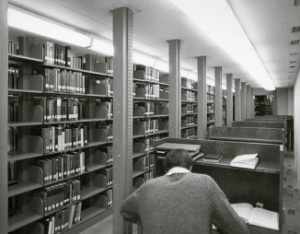
Smullin Library, 1982: “…individual study carrels on bare cement floors under buzzing lights…”
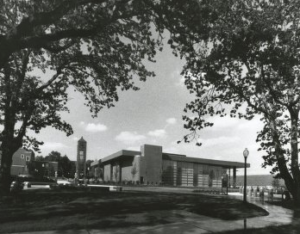
A young Hatfield Library, 1986
